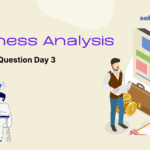Welcome to Day 1 of our series on mastering data analyst interviews! Whether you’re gearing up for your first interview or looking to brush up on your skills, this series will provide you with valuable insights and strategies to help you succeed. Today, we’ll dive into some common interview questions and provide detailed answers to help you prepare effectively.
Question: What is the role of a data analyst, and why is it important for businesses?
Answer: A data analyst plays a crucial role in extracting actionable insights from data to inform business decisions. By analyzing data trends, patterns, and metrics, data analysts help businesses identify opportunities for growth, optimize processes, and improve performance across various departments.
Question: Can you explain the difference between descriptive and inferential statistics?
Answer: Descriptive statistics are used to summarize and describe the main features of a dataset, such as mean, median, mode, and standard deviation. Inferential statistics, on the other hand, involve making predictions or inferences about a population based on sample data. It helps in drawing conclusions and making decisions about the population from which the sample was drawn.
Question: How do you clean and preprocess data before analysis?
Answer: Data cleaning and preprocessing are crucial steps to ensure the quality and reliability of the analysis. This involves tasks such as handling missing values, removing duplicates, standardizing data formats, and scaling features. Techniques like imputation, outlier detection, and normalization are commonly used to prepare the data for analysis.
Question: What tools and technologies are you proficient in for data analysis?
Answer: I am proficient in a variety of tools and technologies commonly used in data analysis, including SQL for data querying and manipulation, Python and R for statistical analysis and modeling, Excel for data visualization and reporting, and Tableau for interactive data visualization.
Question: How would you approach a data analysis project from start to finish?
Answer: When approaching a data analysis project, I would start by clearly defining the objectives and requirements. Next, I would gather and preprocess the relevant data before performing exploratory data analysis to uncover insights and trends. Then, I would apply appropriate statistical or machine learning techniques to answer specific questions or solve business problems. Finally, I would communicate my findings effectively through visualizations and reports.
Question: Can you explain the concept of A/B testing and how it is used in data analysis?
Answer: A/B testing, also known as split testing, is a method used to compare two versions of a variable to determine which one performs better. In data analysis, A/B testing is commonly used in marketing and product optimization to evaluate the impact of changes such as website design, pricing strategies, or ad campaigns. By randomly assigning users to different groups and measuring their response, A/B testing helps businesses make data-driven decisions and improve performance.
Question: What is the difference between correlation and causation?
Answer: Correlation refers to a statistical relationship between two variables, indicating how they change together. However, correlation does not imply causation, meaning that just because two variables are correlated does not necessarily mean that changes in one variable cause changes in the other. Establishing causation requires additional evidence and rigorous analysis to rule out other potential factors.
Question: How do you handle outliers in a dataset?
Answer: Outliers are data points that significantly differ from the rest of the observations in a dataset. Depending on the nature of the data and the analysis goals, outliers can be treated in different ways. Common approaches include removing outliers based on statistical criteria, transforming the data to reduce the impact of outliers, or treating outliers as separate categories for analysis.
Question: Describe a data analysis project you worked on and the insights you derived from it?
Answer: In a previous project, I analyzed customer churn data for a subscription-based service. By examining historical usage patterns, demographic information, and customer interactions, I identified key factors influencing churn rates and developed a predictive model to forecast future churn. The insights generated from the analysis helped the company implement targeted retention strategies and reduce customer attrition.
Question: How do you ensure the confidentiality and integrity of data in your analysis?
Answer: Ensuring data confidentiality and integrity is paramount in data analysis. I adhere to industry best practices and data privacy regulations such as GDPR and HIPAA. This includes implementing encryption techniques, access controls, and anonymization methods to protect sensitive information. Additionally, I regularly audit and monitor data processes to detect and mitigate any security vulnerabilities.
Use Cases
Question: You’re tasked with optimizing inventory management for a retail company. How would you approach this challenge?
Answer: To optimize inventory management, I would start by analyzing historical sales data to identify trends, seasonality, and demand patterns for different products. Using forecasting techniques such as time series analysis or machine learning models, I would predict future demand and optimize inventory levels accordingly. Additionally, I would implement inventory optimization strategies such as ABC analysis, safety stock calculations, and just-in-time inventory management to minimize stockouts and excess inventory costs.
Question: Imagine you’re analysing customer engagement data for a social media platform. How would you measure and improve user retention?
Answer: To measure user retention, I would track metrics such as active user counts, session duration, and user engagement over time. By segmenting users based on behavior, demographics, and usage patterns, I could identify factors influencing retention rates and prioritize strategies to improve user engagement. This may include personalized recommendations, targeted promotions, user experience enhancements, and community-building initiatives to foster long-term user loyalty and retention.










